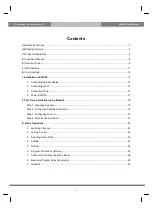
™
Page 59 of 65
9 Interpreting Results
9.
Interpreting Results
9.1 Introduction
Using the vLoc3-DM system can quickly and efficiently assess the general coating of a pipeline network. It can help identify
defects and possible shorts to other structures. It can be used as a tool to prioritize and plan work on the network. However,
unless care is taken when interpreting the results misinterpretation can lead to unnecessary work and expenses.
9.2 Sources of Error
Most errors are either caused by carelessness in taking readings or by interference or distorted signal field.
9.2.1
Operator Error
Care must be taken when taking readings. Great care should be taken to pinpoint the position of the pipeline before a
measurement is taken. The locator must be aligned and held vertically. The measurements are only as good as the care taken
to obtain them.
The sensors used to detect the low-frequency vLoc3-DM profiling signal are very sensitive to low frequencies. Moving the
instrument while the unit calculates the information will cause the strong earth’s magnetic field to induce an interfering signal into
the sensors resulting in errors. The vLoc3-DM must be kept still while it is taking measurements.
9.2.2
Interference (Distorted Fields)
The vLoc3-DM evaluates the electromagnetic field signal radiating from a pipeline to determine the information required. It
assumed that the field is uniformly radiating from the pipe. Unfortunately the field is prone to be distorted, and this can lead to
errors.
9.2.2.1
Source of Interference (Distorted Fields)
Source of Interference (Distorted Fields)
There are many sources of field distortion, but this handbook lists some of the more common sources of distortion:
• Changes in Pipeline Direction
• Adjacent Pipes or Cables
• Cross Bonding
• Passing Vehicles
• Pipe Sleeving
• Changes in Pipeline Direction
Whenever there is a change in the pipeline direction there will be some field distortion. See the diagram below. The sharper the
change the bigger the distortion. Avoid taking measurements at these points.
•
Adjacent Pipes or Cables
Adjacent pipelines or cables very often have a signal induced onto them by capacitance or inductive effects. These signals will
interfere with the signal on the target pipe and will cause distortion. See the diagram below.










































